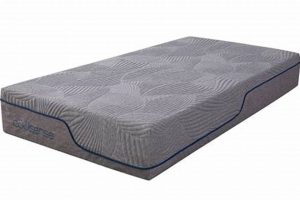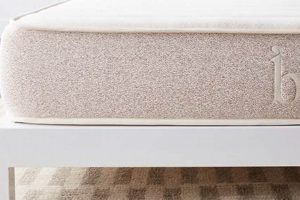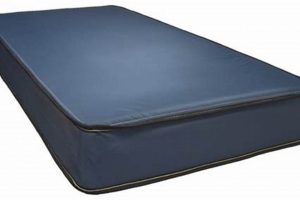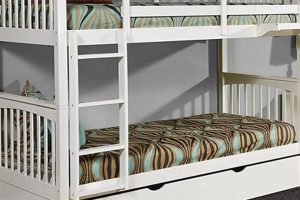A bed designed for single sleepers, incorporating both innerspring coils and foam layers, offers a balance of support and comfort. This type of bedding solution aims to provide pressure relief and spinal alignment, often sought after for children’s rooms, guest rooms, or individuals with limited space. The combination of materials is engineered to deliver the responsive feel of a traditional spring mattress with the conforming properties associated with memory foam or latex.
Such constructions are valued for their versatility, catering to a range of sleep preferences and body types. The spring core provides a stable foundation and promotes airflow, contributing to temperature regulation. The foam layers contour to the body, minimizing motion transfer and reducing pressure points. Historically, the development of these mattresses represents an evolution in sleep technology, addressing consumer demand for improved comfort and support beyond purely innerspring or all-foam designs.
The following sections will delve into specific aspects of these mattresses, including construction variations, material choices, considerations for different sleep positions, and factors relevant to the selection process. This will allow for a more informed decision when choosing the right sleep product.
Hybrid Twin Mattress Selection Tips
Selecting a mattress necessitates careful consideration of various factors to ensure optimal sleep quality and long-term satisfaction. The following tips provide guidance in navigating the selection process.
Tip 1: Evaluate Coil Type and Count: Different coil systems (e.g., pocketed, Bonnell) offer varying levels of support and motion isolation. A higher coil count generally indicates enhanced durability and contouring.
Tip 2: Consider Foam Density and Composition: The density of the foam layers impacts the mattress’s firmness and longevity. Research various foam types such as memory foam, latex, or polyfoam, noting their individual properties and suitability to specific needs.
Tip 3: Assess Edge Support: Robust edge support prevents sagging and maximizes the usable sleep surface. Look for reinforced edges or coil systems that extend to the perimeter.
Tip 4: Examine Cover Material and Construction: The mattress cover should be breathable and durable. Consider features like antimicrobial properties or moisture-wicking capabilities.
Tip 5: Verify Thickness and Profile: The overall thickness affects the perceived firmness and ease of getting in and out of bed. Choose a profile that aligns with individual preferences and any existing bed frames.
Tip 6: Review Trial Periods and Warranties: Reputable manufacturers offer trial periods allowing customers to test the mattress at home. Comprehensive warranties offer protection against manufacturing defects and premature wear.
Tip 7: Research Third-Party Certifications: Look for certifications such as CertiPUR-US, which ensures that the foams used are low in volatile organic compounds (VOCs) and free from harmful substances.
Careful evaluation of these factors contributes to a more informed decision, enhancing the likelihood of selecting a mattress that promotes restful sleep and supports overall well-being.
The subsequent sections will explore specific mattress brands and models, offering comparative analyses to facilitate a comprehensive understanding of available options.
1. Coil Support
The innerspring coil system serves as the foundational support core within a hybrid twin mattress. It directly influences the mattress’s ability to provide proper spinal alignment and distribute weight evenly. The type, gauge, and arrangement of the coils impact the firmness, responsiveness, and overall support provided. A coil system that is inadequate or poorly constructed can lead to sagging, pressure points, and compromised sleep quality. For example, a hybrid twin mattress with a low-gauge (thicker) coil system arranged in a continuous coil design might offer firm support, suitable for individuals who sleep on their backs or stomachs. In contrast, a pocketed coil system, where each coil is individually wrapped, allows for more independent movement and can better contour to the body, reducing motion transfer.
The density and configuration of the coil layer are crucial to the long-term performance of the mattress. A greater number of coils, particularly in pocketed coil systems, generally translates to improved support and reduced motion disturbance. The edge support of the coil system is also significant; reinforced edges prevent roll-off and increase the usable surface area of the mattress. Improper coil support can cause the mattress to wear unevenly, reducing its lifespan and potentially leading to discomfort or even back pain. The specification of the coil system, therefore, is a primary consideration in the design and selection of a hybrid twin mattress.
In summary, the coil support component of a hybrid twin mattress is integral to its structural integrity and the quality of the sleep experience it delivers. Understanding the characteristics of different coil systems empowers consumers to make informed decisions tailored to their individual support needs and preferences. Neglecting this aspect can result in a mattress that fails to provide adequate support, compromising sleep quality and potentially leading to long-term discomfort.
2. Foam Comfort
The integration of foam layers significantly influences the comfort characteristics of a hybrid twin mattress. These layers work in conjunction with the innerspring system to provide cushioning, pressure relief, and contouring, shaping the overall sleep experience. The type, density, and thickness of the foam directly affect the mattress’s feel and suitability for various sleep preferences.
- Material Composition and Feel
The choice of foam materials, such as memory foam, latex, or polyurethane foam, dictates the mattress’s surface feel and responsiveness. Memory foam conforms closely to the body, offering significant pressure relief, while latex provides a more resilient and buoyant feel. Polyurethane foam serves as a general cushioning layer. Each material contributes unique properties to the overall comfort profile of the mattress. For example, a hybrid twin mattress with a thick layer of high-density memory foam may be well-suited for side sleepers who require enhanced pressure relief at the shoulders and hips.
- Density and Durability
Foam density is a critical factor in determining the mattress’s durability and long-term support. Higher-density foams generally resist compression and maintain their shape over time, extending the mattress’s lifespan. Conversely, lower-density foams may break down more quickly, leading to sagging and reduced support. The density of the foam layers in a hybrid twin mattress directly co
rrelates with its ability to withstand consistent use and maintain its comfort level. - Thickness and Pressure Relief
The thickness of the foam layers affects the mattress’s ability to distribute weight and alleviate pressure points. Thicker foam layers provide greater cushioning and can effectively reduce pressure on sensitive areas such as the shoulders, hips, and knees. This is particularly important for individuals who experience joint pain or pressure-related discomfort during sleep. A hybrid twin mattress with a substantial foam layer can significantly enhance comfort and promote more restful sleep.
- Temperature Regulation
Foam layers can impact the mattress’s temperature regulation capabilities. Some foam types, such as open-cell memory foam or latex, are designed to promote airflow and dissipate heat, preventing the sleeper from overheating. Traditional memory foam, however, can trap heat, potentially leading to discomfort for some individuals. The breathability of the foam layers is a key consideration when selecting a hybrid twin mattress, particularly for those who tend to sleep hot.
In essence, the foam component of a hybrid twin mattress is a crucial determinant of its comfort level. The selection of foam materials, their density, thickness, and breathability all contribute to the mattress’s ability to provide proper support, pressure relief, and temperature regulation, ultimately impacting the quality of sleep experienced by the user. Careful consideration of these factors is essential for selecting a mattress that meets individual comfort needs and preferences.
3. Edge Support
Edge support is a critical component in hybrid twin mattresses, influencing the usable sleep surface, overall stability, and long-term durability of the product. The perimeter of the mattress is often subjected to concentrated pressure from sitting or lying near the edge, necessitating robust reinforcement.
- Usable Sleep Surface
Strong edge support maximizes the available sleep area. A mattress with weak edges allows the sleeper to feel as though they might roll off, restricting them to the center. A reinforced edge provides a stable surface, enabling full utilization of the mattress width. This is particularly beneficial for single sleepers who prefer to spread out or those sharing the mattress infrequently.
- Sag Prevention
Inadequate edge support can lead to premature sagging around the perimeter of the mattress. This sagging creates an uneven sleeping surface, potentially causing discomfort and disrupting spinal alignment. Robust edge reinforcement helps maintain the mattress’s shape and support integrity over time, preventing localized depressions.
- Entry and Exit Assistance
A firm edge facilitates easier and more stable entry and exit from the bed. Individuals with mobility issues or those who prefer to sit on the edge of the bed find enhanced support to be a significant advantage. The presence of solid edge support offers a secure and stable platform for these activities.
- Structural Integrity
Edge support contributes to the overall structural integrity of the mattress. It prevents the sides from collapsing or deforming, particularly under consistent pressure. This structural stability ensures the mattress maintains its shape and functionality throughout its lifespan, providing reliable support.
These elements of edge support are crucial in determining the suitability of a hybrid twin mattress. A mattress that incorporates reinforced edges will generally offer a more comfortable, durable, and stable sleep surface compared to one lacking this feature. Consideration of edge support is essential for optimizing the sleep experience and maximizing the longevity of the mattress.
4. Size specifications
The size specifications of a hybrid twin mattress are fundamental to its utility and suitability within specific contexts. Defined dimensions directly influence the mattress’s ability to fit within standard twin bed frames, impacting bedroom layout and space utilization. Deviation from standard measurements, even by a small margin, can lead to compatibility issues with existing bedroom furniture, requiring adjustments or even replacement of bed frames. The standard twin mattress dimensions, typically around 38 inches wide by 75 inches long, are designed to accommodate a single sleeper comfortably while optimizing space efficiency. Accurate adherence to these specifications during manufacturing ensures seamless integration into bedrooms designed for twin-sized beds. For example, college dormitories and children’s rooms often rely on the standardized dimensions of twin mattresses to maximize space and accommodate multiple beds within a limited area.
Beyond the overall dimensions, the thickness, or profile, of the hybrid twin mattress also plays a critical role. The mattress profile affects the overall height of the bed, influencing ease of entry and exit, particularly for children or individuals with mobility limitations. A mattress that is excessively thick may require the use of lower-profile bed frames or foundations to maintain a comfortable bed height. Conversely, a thinner mattress may require additional support to achieve the desired level of comfort and support. For instance, an individual purchasing a hybrid twin mattress for a bunk bed must consider the height of the mattress to comply with safety regulations and ensure adequate headroom for the upper bunk.
In conclusion, the size specifications of a hybrid twin mattress are not merely arbitrary measurements but essential parameters that determine its compatibility, functionality, and safety within various environments. Accurate adherence to these specifications during manufacturing, coupled with careful consideration by the purchaser, ensures optimal utilization of space, ease of use, and overall satisfaction. Neglecting these specifications can lead to practical challenges, ranging from incompatibility with existing furniture to compromised safety and comfort.
5. Temperature Regulation
Temperature regulation within a hybrid twin mattress directly impacts sleep quality and comfort. Overheating is a known disruptor of sleep cycles, causing restlessness and fragmented sleep patterns. The design and material choices in hybrid mattresses play a crucial role in mitigating heat retention and promoting a cooler sleep environment. The innerspring system, a core component of the hybrid construction, inherently allows for greater airflow compared to solid foam mattresses. This ventilation facilitates the dissipation of body heat, reducing the likelihood of overheating. For example, individuals residing in warmer climates or those prone to night sweats often find hybrid mattresses more conducive to restful sleep due to this enhanced breathability.
The specific types of foam layers used in the hybrid construction also contribute significantly to temperature regulation. Traditional memory foam, known for its conforming properties, can sometimes trap heat. However, advancements in foam technology have led to the development of open-cel
l memory foam and gel-infused memory foam, both designed to improve airflow and dissipate heat more effectively. Latex foam, whether natural or synthetic, is another option often incorporated into hybrid mattresses due to its inherent breathability and ability to wick away moisture. The selection of these materials, and their strategic placement within the mattress layers, is paramount to achieving optimal temperature regulation. For instance, a hybrid twin mattress employing a layer of gel-infused memory foam directly beneath a breathable cotton cover can provide a noticeably cooler sleep surface.
In summary, temperature regulation is an indispensable consideration when evaluating a hybrid twin mattress. The combination of an innerspring system that promotes airflow and carefully selected foam layers with enhanced breathability characteristics is essential for preventing overheating and fostering a comfortable sleep environment. Failure to prioritize temperature regulation can result in disrupted sleep, decreased comfort, and ultimately, dissatisfaction with the mattress. Therefore, consumers should carefully examine the materials and construction of hybrid twin mattresses, paying close attention to features designed to enhance airflow and minimize heat retention, to ensure a cooler, more restful sleep experience.
6. Durability
The lifespan of a hybrid twin mattress is significantly influenced by the quality of materials and construction techniques employed. Durability, in this context, directly correlates with the ability of the mattress to maintain its structural integrity and comfort characteristics over an extended period. Inferior materials or flawed construction can lead to premature sagging, loss of support, and a decline in overall sleep quality. The innerspring coil system, a core component, must withstand repeated compression and weight distribution; low-gauge coils or inadequate coil density can result in coil fatigue and subsequent deformation of the mattress. The foam layers, similarly, are subject to compression and wear; low-density foams are more prone to breakdown and loss of resilience, diminishing the mattress’s comfort and support over time. A practical example illustrates this: a hybrid twin mattress utilizing high-density memory foam and pocketed coils may retain its shape and supportive qualities for several years, while a comparable mattress with low-density foam and less robust coils may exhibit noticeable sagging and discomfort within a shorter timeframe.
Furthermore, the mattress cover and edge support system play crucial roles in determining overall durability. A weak or poorly constructed cover is susceptible to tearing and abrasion, exposing the inner components to potential damage. Inadequate edge support can lead to edge collapse, reducing the usable sleep surface and compromising the mattress’s structural integrity. The choice of materials for these components, such as durable fabrics and reinforced edge coils, significantly impacts the mattress’s ability to withstand daily use and maintain its form. For instance, a hybrid twin mattress featuring a reinforced edge and a tightly woven cover is likely to exhibit greater resistance to wear and tear, extending its lifespan and maintaining its aesthetic appeal.
In summary, durability is a critical factor to consider when assessing a hybrid twin mattress. The interplay between coil quality, foam density, cover material, and edge support directly influences the mattress’s longevity and its ability to provide consistent comfort and support. Prioritizing durability ensures a greater return on investment, reducing the likelihood of premature replacement and contributing to long-term sleep satisfaction. Understanding the material specifications and construction methods employed in a hybrid twin mattress is therefore essential for making an informed purchase decision and securing a durable, high-quality sleep surface.
7. Motion Isolation
Motion isolation, the ability of a mattress to minimize the transfer of movement from one area to another, is a significant attribute in sleep products, particularly when considering shared sleep surfaces. Hybrid twin mattresses, engineered with a combination of innerspring coils and foam layers, offer a specific approach to addressing motion isolation challenges. The extent to which a hybrid twin mattress effectively isolates motion is dictated by the configuration and properties of its constituent components. The innerspring system, while providing support and responsiveness, can inherently transmit motion. However, the presence of individually pocketed coils, where each spring is encased in fabric, significantly reduces motion transfer compared to interconnected coil systems. These pocketed coils respond independently to pressure, minimizing the propagation of movement across the mattress surface. For example, in a twin mattress used in a shared child’s room, a child tossing and turning may cause less disturbance to their sibling’s sleep on a mattress equipped with superior motion isolation capabilities.
The foam layers in a hybrid twin mattress also play a crucial role in mitigating motion transfer. Memory foam, with its visco-elastic properties, excels at absorbing and dampening movement. Its ability to conform to the body’s contours and isolate pressure points effectively prevents motion from spreading across the mattress. Latex foam, while more responsive than memory foam, still provides a degree of motion isolation, particularly when used in conjunction with pocketed coils. The density and thickness of the foam layers also influence their motion-isolating properties. Denser and thicker foam layers generally absorb more motion than thinner, less dense layers. Consider a scenario where a restless sleeper frequently changes positions throughout the night. A hybrid twin mattress with a substantial layer of high-density memory foam over pocketed coils would likely provide greater motion isolation, minimizing disturbance to a co-sleeper or even to the sleeper themselves due to reduced self-induced movement.
In summary, motion isolation is a desirable characteristic in hybrid twin mattresses, achieved through the strategic combination of pocketed coils and motion-absorbing foam layers. The effectiveness of motion isolation is dependent on the quality and configuration of these components. While hybrid mattresses may not offer the same level of motion isolation as all-foam mattresses, the combination of support, responsiveness, and motion dampening makes them a viable option for individuals seeking a balance of these attributes. Understanding the interplay between coil type, foam density, and overall mattress construction is critical for selecting a hybrid twin mattress that adequately addresses motion isolation needs.
Frequently Asked Questions
This section addresses common inquiries and clarifies important aspects regarding hybrid twin mattresses. It aims to provide concise and factual information to assist in making informed purchasing decisions.
Question 1: What defines a hybrid twin mattress?
A hybrid twin mattress is characterized by the combination of two distinct support systems: an innerspring coil core and one or more layers of foam (typically memory foam, latex, or polyurethane foam) for comfort. This design seeks to blend the support of a traditional innerspring mattress with the contouring comfort of foam.
Question 2: How does a hybrid twin mattress differ from an all-foam twin mattress? strong>
The fundamental difference lies in the core support system. An all-foam mattress relies solely on various foam layers for support and comfort, whereas a hybrid twin mattress incorporates an innerspring coil system as its primary support base, supplemented by foam layers for added comfort and pressure relief.
Question 3: Are hybrid twin mattresses suitable for all sleep positions?
Hybrid twin mattresses can accommodate a range of sleep positions, but their suitability depends on the specific firmness level and the configuration of the foam layers. Side sleepers generally benefit from a softer mattress with conforming foam, while back and stomach sleepers typically require a firmer mattress for adequate spinal support.
Question 4: What factors influence the durability of a hybrid twin mattress?
Durability is primarily determined by the quality of the materials used in both the coil system and the foam layers. Higher-gauge coils, denser foams, and a robust mattress cover contribute to a longer lifespan and greater resistance to sagging or deformation.
Question 5: Do hybrid twin mattresses effectively isolate motion?
Motion isolation varies depending on the type of coil system and the density of the foam layers. Individually pocketed coils tend to minimize motion transfer more effectively than interconnected coil systems. Higher-density foams also absorb motion, reducing the likelihood of disturbances to a sleeping partner.
Question 6: How does the price of a hybrid twin mattress compare to other types of twin mattresses?
Hybrid twin mattresses generally fall within a mid-range price point, often costing more than traditional innerspring mattresses but less than specialized all-latex or high-end memory foam mattresses. Pricing is influenced by factors such as material quality, brand reputation, and construction complexity.
In summary, hybrid twin mattresses present a blend of support and comfort, offering potential benefits for a wide range of sleepers. Careful consideration of material quality, coil system type, and foam density is essential for selecting a mattress that meets individual needs and preferences.
The subsequent sections will explore specific brand comparisons and offer guidance on optimizing the sleep environment to complement the chosen mattress.
Hybrid Twin Mattress
This exploration of the hybrid twin mattress has underscored its dual nature, combining the support of innerspring coils with the comfort of foam. The quality and configuration of each componentcoil system, foam type, edge supportdictate the mattress’s performance in terms of support, pressure relief, durability, and motion isolation. Furthermore, considerations of size specifications and temperature regulation play a crucial role in determining overall suitability.
The hybrid twin mattress represents a viable option for those seeking a balanced sleep solution. Its success, however, hinges on a thorough assessment of individual needs and a critical evaluation of product specifications. Continued advancements in materials and construction techniques promise further refinements in hybrid mattress technology, potentially leading to enhanced comfort, support, and longevity in the future.





![Best Walmart Twin Size Blow Up Mattress [Guide] Organic & Natural Mattress Buyer’s Guide: Non-Toxic Sleep Solutions Best Walmart Twin Size Blow Up Mattress [Guide] | Organic & Natural Mattress Buyer’s Guide: Non-Toxic Sleep Solutions](https://mattressworldpa.com/wp-content/uploads/2025/07/th-5075-300x200.jpg)

